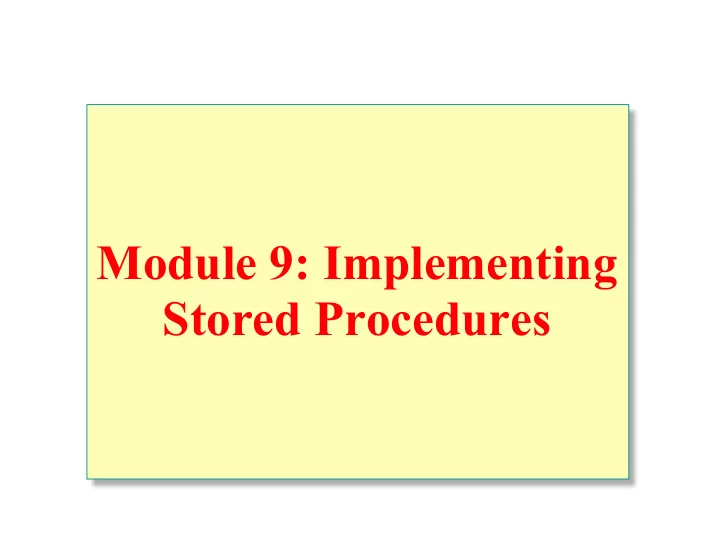

Module 9: Implementing Stored Procedures
Overview Introduction to Stored Procedures Creating Executing Modifying Dropping Using Parameters in Stored Procedures Executing Extended Stored Procedures Handling Error Messages
Introduction to Stored Procedures Defining Initial Processing Subsequent Processing Advantages
Introduction: Defining Stored Procedures Named Collections of Transact-SQL Statements Accept Input Parameters and Return Values Return Status Value to Indicate Success or Failure Encapsulate Repetitive Tasks Five Types System, Local, Temporary, Remote, Extended
Introduction: Initial Processing of Stored Procedures Creation Creation Entries into sysobjects Parsing and syscomments tables Execution Execution Optimization (first time (first time or recompile) or recompile) Compiled plan placed in Compilation procedure cache
Introduction: Subsequent Processing of Stored Procedures Execution Plan Retrieved Execution Plan Execution Context Connection 1 8082 SELECT * FROM Connection 2 dbo. member 24 WHERE member_no = ? Connection 3 1003 Unused plan is aged out
Introduction: Advantages of Stored Procedures Share Application Logic Shield Database Schema Details Provide Security Mechanisms Improve Performance Reduce Network Traffic
Creating, Executing, Modifying, and Dropping Stored Procedures Creating Guidelines for Creating Executing Altering and Dropping
Creating Stored Procedures Create in Current Database Using the CREATE PROCEDURE (or CREATE PROC) Statement USE Northwind GO CREATE PROC dbo.OverdueOrders AS SELECT * FROM dbo.Orders WHERE RequiredDate < GETDATE() AND ShippedDate IS Null GO Can Nest to 32 Levels Use sp_help to Display Information sp_help <procedure name>
Guidelines for Creating Stored Procedures dbo User Should Own All Stored Procedures E.g., dbo.OverdueOrders One Stored Procedure for One Task Create, Test, and Troubleshoot Avoid sp_ Prefix in Stored Procedure Names Used for system store procedures Use Same Connection Settings for All Stored Procedures Minimize Use of Temporary Stored Procedures Never Delete Entries Directly From Syscomments
Executing Stored Procedures Executing a Stored Procedure by Itself EXEC OverdueOrders Executing a Stored Procedure Within an INSERT Statement INSERT INTO Customers EXEC EmployeeCustomer Inserts the results from the Query in EmployeeCustomer
Altering and Dropping Stored Procedures Altering Stored Procedures Include any options in ALTER PROCEDURE (or ALTER PROC) Does not affect nested stored procedures USE Northwind GO ALTER PROC dbo.OverdueOrders AS SELECT CONVERT(char(8), RequiredDate, 1) RequiredDate, CONVERT(char(8), OrderDate, 1) OrderDate, OrderID, CustomerID, EmployeeID FROM Orders WHERE RequiredDate < GETDATE() AND ShippedDate IS Null ORDER BY RequiredDate GO Dropping stored procedures Execute the sp_depends stored procedure to determine whether objects depend on the stored procedure
Using Parameters in Stored Procedures Using Input Parameters Executing Using Input Parameters Returning Values Using Output Parameters Explicitly Recompiling
Using Input Parameters Validate All Incoming Parameter Values First Highly recommended since testing and fixing is harder Provide Appropriate Default Values and Include Null Checks CREATE PROCEDURE dbo.[Year to Year Sales] @BeginningDate DateTime, @EndingDate DateTime AS IF @BeginningDate IS NULL OR @EndingDate IS NULL BEGIN RAISERROR('NULL values are not allowed', 14, 1) RETURN END SELECT O.ShippedDate, O.OrderID, OS.Subtotal, DATENAME(yy,ShippedDate) AS Year FROM ORDERS O INNER JOIN [Order Subtotals] OS ON O.OrderID = OS.OrderID WHERE O.ShippedDate BETWEEN @BeginningDate AND @EndingDate GO
Executing Stored Procedures Using Input Parameters Passing Values by Parameter Name More robust but requires parameter names and tighter coordination EXEC AddCustomer between developers. @CustomerID = 'ALFKI', @ContactName = 'Maria Anders', @CompanyName = 'Alfreds Futterkiste', @ContactTitle = 'Sales Representative', @Address = 'Obere Str. 57', @City = 'Berlin', @PostalCode = '12209', @Country = 'Germany', @Phone = '030-0074321' Less robust but supports Passing Values by Position “programming to interfaces.” EXEC AddCustomer 'ALFKI2', 'Alfreds Futterkiste', 'Maria Anders', 'Sales Representative', 'Obere Str. 57', 'Berlin', NULL, '12209', 'Germany', '030-0074321'
Returning Values Using Output Parameters CREATE PROCEDURE dbo.MathTutor Creating Stored Creating Stored @m1 smallint, Procedure Procedure @m2 smallint, @result smallint OUTPUT AS SET @result = @m1* @m2 GO Executing Stored Executing Stored DECLARE @answer smallint Procedure Procedure EXECUTE MathTutor 5,6, @answer OUTPUT SELECT 'The result is: ', @answer Results of Stored Results of Stored The result is: 30 Procedure Procedure
Explicitly Recompiling Stored Procedures Recompile When the Execution Plan Changes Stored procedure returns widely varying result sets A new index is added to an underlying table The parameter value is atypical Recompile by Using CREATE PROCEDURE [WITH RECOMPILE] EXECUTE [WITH RECOMPILE] sp_recompile <procedure name>
Executing Extended Stored Procedures Are Programmed Using Open Data Services API Can Include C, C++, Java Features Can Contain Multiple Functions Can Be Called from a Client or SQL Server Can Be Added to the master Database Only E.g., Execute a command in cmdshell. EXEC master..xp_cmdshell 'dir c:\'
Handling Error Messages RETURN Statement Exits Query or Procedure Unconditionally sp_addmessage Creates Custom Error Messages @@error Contains Error Number for Last Executed Statement RAISERROR Statement Returns user-defined or system error message Sets system flag to record error
Performance Considerations Windows 2000 System Monitor Object: SQL Server: Cache Manager Object: SQL Statistics SQL Profiler Can monitor events Can test each statement in a stored procedure
Recommended Practices Verify Input Parameters Design Each Stored Procedure to Accomplish a Single Task Validate Data Before You Begin Transactions Use the Same Connection Settings for All Stored Procedures Use WITH ENCRYPTION to Hide Text of Stored Procedures
Review Introduction to Stored Procedures Creating Executing Modifying Dropping Using Parameters in Stored Procedures Executing Extended Stored Procedures Handling Error Messages
Recommend
More recommend